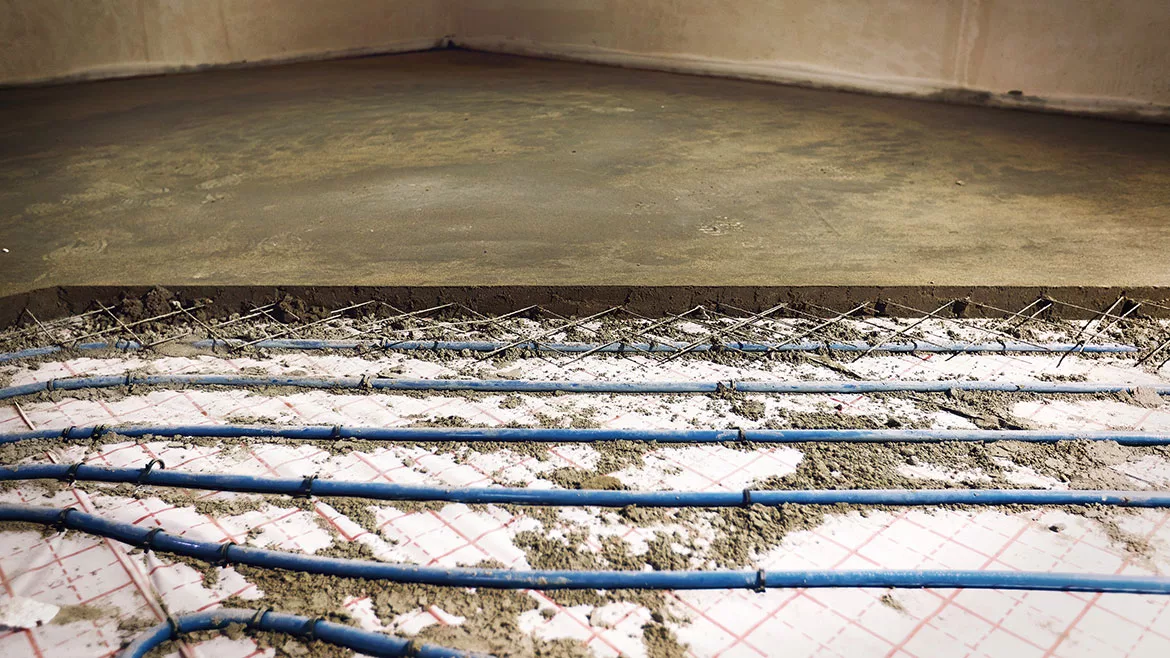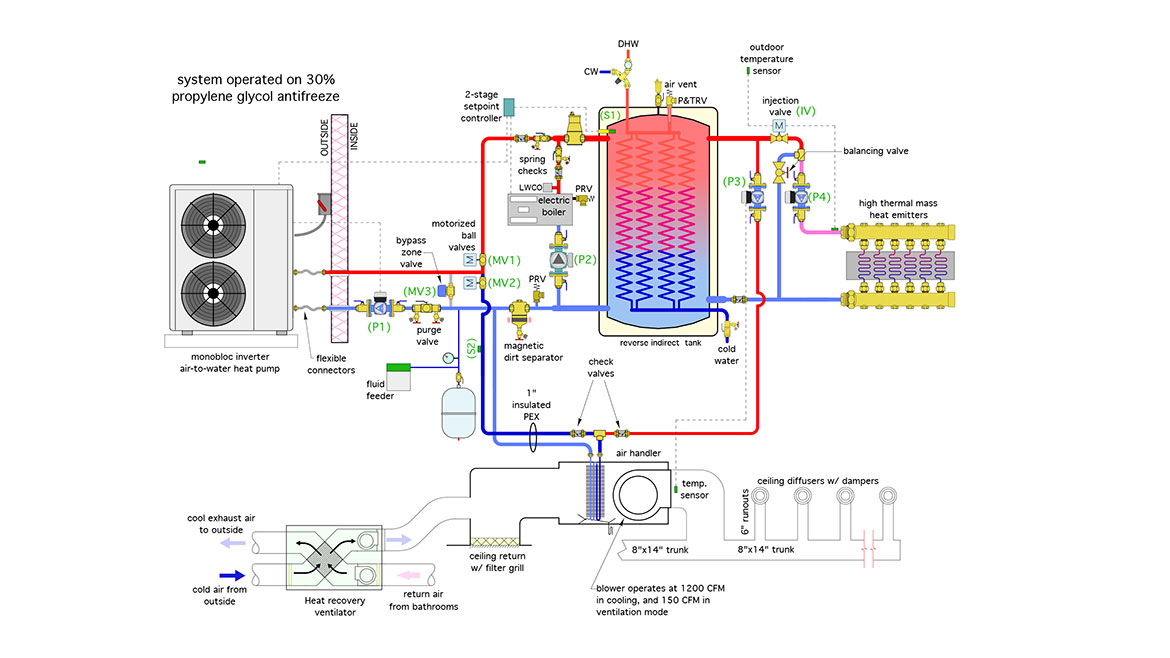Hydronics Workshop | John Siegenthaler
Cutting-edge hydronics technology delivers superior efficiency and comfort
Chill chaser.

Image Source: Bondariev / iStock / Getty Images Plus
Hydronically-heated concrete floor slabs can deliver silent, steady and superior comfort. Their high thermal mass can dampen out reasonable variations in heat input to an extent that occupants are unaware that such variations even exist. The same thermal mass can also deliver “full afterburner” heat output when cold outside air slides over the heated floor from an open overhead door. That “burst” of heat output quickly restores comfort when that door is closed. The concept that the floor slab can act as a thermal storage device to absorb heat from sources such as a heat pump running on low-cost off-peak rates is also an attractive quality and one that has the potential to keep hydronic-based systems highly relevant as utilities plan how to meet future electrification goals.
So what’s not to like about heated floor slabs?
Think about a cool rainy day in early fall as a cold front moves through dropping the outdoor temperature to 45° F for a short time. The air is damp, and the heated slab system has not yet been turned on for the season. The weather forecast is for sunshine and temperatures in the mid-70s to return the next day.
Should that floor slab heating system be turned on to chase the chill away for the next few hours?
Consider a Western location where the overnight temperature in early fall drops into the upper 30s, but “Chinook winds” and sunshine the following day bring the outdoor temperature into the upper 70s, likely causing the building’s cooling system to run the following afternoon.
Should that same slab heating system be turned on during that cool but short-lived overnight period, knowing that “summer-like” conditions are only a few hours away?
Let’s assume the answer to the two previous questions is yes. The occupants, feeling slightly uncomfortable, flip the switch to start the system.
If the water temperature supplied to the floor circuits is controlled based on outdoor reset control, the supply temperature might only be in the upper-70° F to mid-80° F range when the outdoor temperature is 45-50° F. Although those water temperatures are above room temperature, the difference is small. It’s going to take several hours for the floor to make much improvement in comfort. By the time the floor warms, the load could be eliminated by warmer outdoor temperatures, or internal heat gains from sunlight, people, etc. If cooling is required by the following afternoon, any heat that continues to percolate from the floor just adds to the cooling load.
Rapid response
Wouldn’t it be nice to have a system that can quickly warm the interior air, without waiting for hours as the floor slab slowly warms? Imagine a hydronic system with a “first gear” to quickly accelerate the space to some degree of comfort, as well as a “high gear” to keep that comfort cruising along when the dead of winter sets in.
Consider the system shown in Figure 1.
FIGURE 1


This system uses a monobloc air-to-water heat pump as its lead heat source. An electric boiler provides supplemental and backup heating when necessary. Both heat sources supply a reverse indirect tank that serves as a buffer for supplying stable domestic hot water, as well as a hydraulic separating device for all four circulators in the system. This tank can also buffer a small space heating load — to be described shortly.
When the heat pump is first turned on in heating mode, the bypass zone valve (MV3) is open, and motorized ball valves (MV1) and (MV2) are closed. This allows the fluid to recirculate back through the heat pump until it reaches a temperature just above that in the upper portion of the tank. At that point, (MV1) opens and the bypass valve closes. Heated fluid is delivered to the reverse indirect to maintain its temperature between 115° and 125° F.
A similar control scenario is used when the heat pump turns on in cooling mode. The bypass valve (MV3) is open, and both (MV1) and (MV2) are closed. The fluid recirculates through the heat pump and quickly reaches a suitable temperature for cooling. At that point, (MV2) opens, the bypass valve closes and chilled fluid is delivered to the coil in the air handler. Flow through the air handler’s coil is provided by the same circulator (P1) that creates flow through the heat pump. If the heat pump has a variable speed compressor, its cooling capacity is regulated to maintain a pre-set supply temperature to the coil — typically in the range of 45° to 55° F.
See my September 2024 Hydronics Workshop column for more information on how to control these three motorized valves based on temperature.
Make me warm…
There are two heating load circuits on the right side of the tank. One goes to the air handler, the other supplies the high thermal mass floor heating system.
Circulator (P3) provides a flow of warm fluid from the upper portion of the tank to the coil in the air handler. This is the “rapid response” heating method for those cool/damp fall days.
Ideally, (P3) is a variable-speed circulator that responds to the air temperature leaving the air handler. The faster the circulator runs, the warmer the leaving air temperature. Variable-speed “setpoint” circulators have been available on the market for several years, and are ideal for this application.
After passing through the air handler coil the cooler fluid returns to the lower portion of the indirect tank. Some or all of the flow leaving the coil might also go to the heat pump if it’s operating.
The high thermal mass floor heating system is also sourced from the upper portion of the tank. The supply temperature to the floor circuits is regulated by a motorized “injection” valve (IV), which is controlled based on outdoor reset. The greater the flow rate passing through the valve, the warmer the supply temperature to the floor circuits.
A simple 2-stage temperature setpoint controller operates the air-to-water heat pump — or if necessary — the electric boiler, to maintain the upper portion of the tank between 115° and 125° F.
That’s high enough to provide reasonable DHW delivery at 110° F, and also well within the operating range of modern air-to-water heat pumps, especially those operating on R-32, R-454B or eventually on R-290 (propane).
Let me breathe…
Modern homes built to ever-tightening energy codes often require mechanical ventilation. The preferred method for exchanging stale air for fresh air is through a heat recovery ventilator (HRV).
Figure 1 shows an HRV tapped into the return side of the air handler. This ventilator draws air from the bathrooms, extracts up to 70% of the heat from that air, and transfers it to the incoming fresh air stream. That “conditioned” fresh air is then injected at the return side of the air handler.
A typical ventilation rate for a modest single family home is 5 cfm per 100 square feet of floor area. This equates to 125 cfm for a 2,500-square-foot house. That’s well below the airflow rate of 300-350 cfm per ton of cooling.
A typical 3-ton rated air handler could be operated at 900-1,050 cfm to distribute the fresh air to all supply diffusers in the building, but doing so needlessly increases the power demand of the blower when only ventilation (and not cooling) is required. Modern blowers with electronically-commutated (EC) motors often have speed tappings, allowing them to operate a lower flow rates in the range of what the HRV produces. This minimizes power input while distributing the fresh air through the same ducting system used for cooling. A different motor speed tapping is activated to provide high air flow rates when the system is in cooling mode.
Additional feature
Consider a situation in a cold northern climate where the outdoor temperature is -10° F. If the HRV recovers 70% of the sensible heat from the outgoing 70° F air, the incoming fresh air stream leaves the HRV at about 46° F. That’s still pretty cool to be introduced directly into occupied space.
This is where the variable speed setpoint circulator (P3) can provide additional functionality. It can operate to create a small flow rate of heated fluid through the air handler coil to boost the incoming fresh 46° F air up to a neutral temperature in the range of 70-75° F before that air is introduced into occupied spaces.
Since a monobloc heat pump is being used, the entire system needs to operate with an antifreeze solution. This protects the heat pump during a power outage or other situation when it remains off for several hours at sub-freezing outdoor temperatures. It also provides freeze protection for the air handler coil.
Remaining relevant
Consumers have lots of choices when it comes to HVAC systems. Contemporary systems such as ductless mini-split heat pumps are incessantly pushed as being a state-of-the-art solution. In reality, these heat pumps provide forced air heating and cooling, but not domestic water heating and heat recovery ventilation. They’re a “partial” solution.
The system shown in Figure 1 provides a complete HVAC solution. It’s well-suited to modern “electrified” homes and can be assembled from readily available components. It’s a system that demonstrates how hydronics technology is not passé, but rather “cutting-edge” in its versatility, energy efficiency and its ability to deliver superior comfort.
It’s up to us — the North American hydronics industry — to keep hydronic-based systems relevant amidst all the marketing efforts for competing HVAC options. It’s up to us to educate homeowners, builders, architects and energy consultants how a hydronic-based system, using multiple-function air delivery subsystems, can provide complete solutions for HVAC using the latest heat pump technology. Collectively, we have the technology to provide superior and complete solutions for HVAC. Learn it, believe it, design it and sell it.
As 2024 comes to a close I wish you and your family a merry and blessed Christmas.
Looking for a reprint of this article?
From high-res PDFs to custom plaques, order your copy today!








